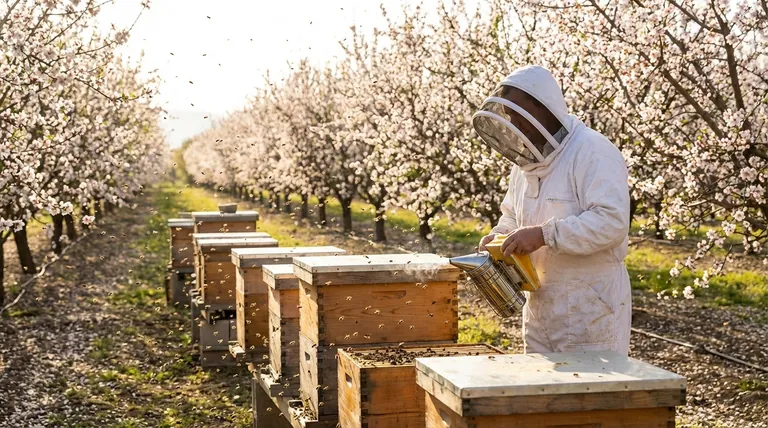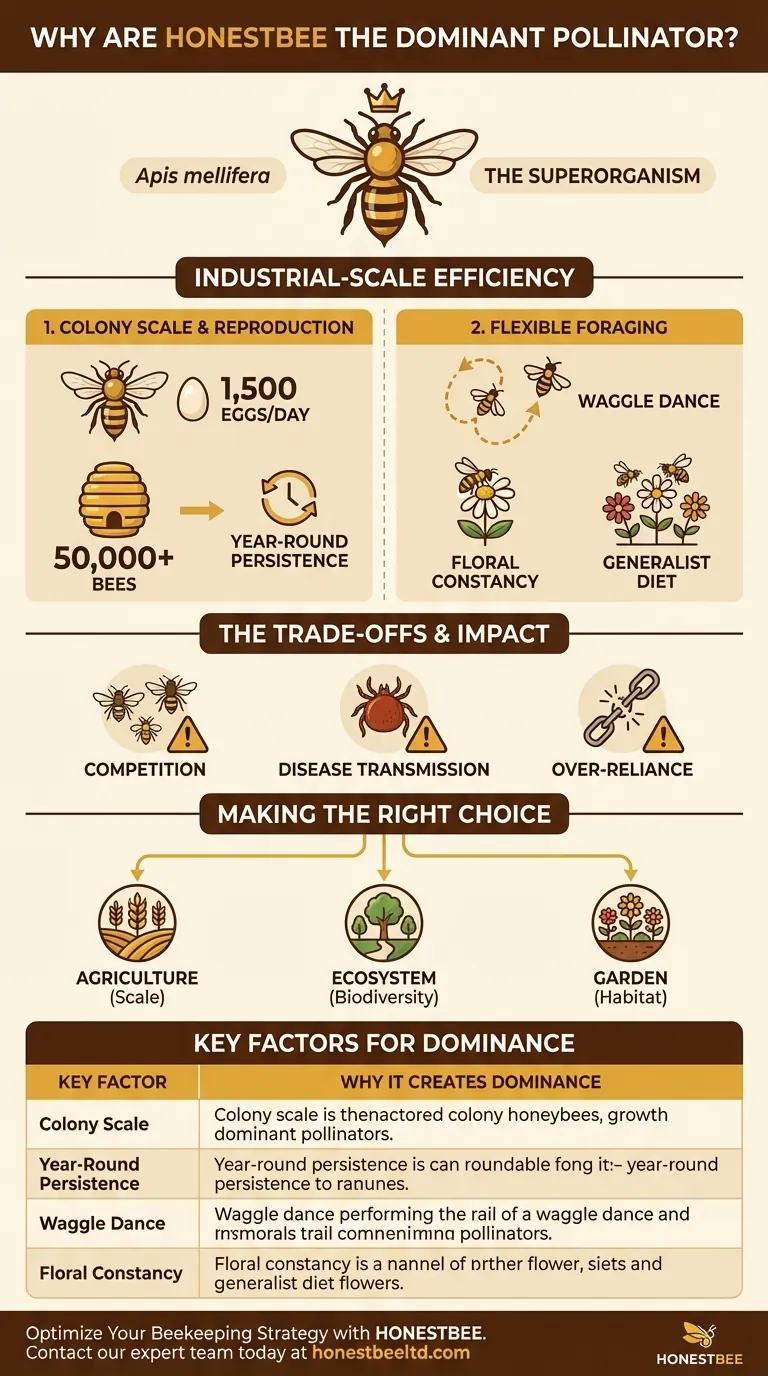At its core, the dominance of the honey bee (Apis mellifera) as a pollinator is not due to the superiority of any single bee, but to the industrial-scale efficiency of the colony as a whole. This dominance stems from two key factors: the ability to maintain massive populations and a suite of highly effective, coordinated foraging behaviors that are unmatched in the insect world.
The honey bee's success is a story of the superorganism. While native bees may be more efficient on a per-bee basis for specific plants, no other pollinator can deploy a massive, organized, and adaptable workforce on the scale of a honey bee colony.

The Power of the Superorganism: Unpacking Colony Scale
The most visible reason for honey bee dominance is their sheer numbers. A single colony acts as a centrally organized force multiplier, capable of saturating an environment with tens of thousands of individual pollinators.
Industrial-Scale Reproduction
The engine of the honey bee colony is the queen. A healthy queen can lay over 1,500 eggs per day, fueling explosive population growth that other pollinators cannot replicate.
This reproductive capacity allows for the commercial production of queens and colonies on a massive scale, making them a predictable and transportable agricultural input.
Unmatched Population Density
A single, healthy honey bee hive can house 50,000 to 60,000 bees. In contrast, most of the 4,000 native bee species in North America are solitary and raise only a handful of offspring each year.
When a crop like almonds comes into bloom, millions of honey bees can be deployed almost overnight, a logistical feat impossible with wild pollinators.
Year-Round Persistence
Honey bee colonies overwinter as a complete social unit. They do not die off, leaving only a hibernating queen, as bumble bees do.
This means a strong, established workforce is ready to fly on the very first warm days of spring, giving them a significant head start in pollinating early-blooming crops.
The Strategic Advantage: Flexible Foraging Behaviors
Beyond sheer numbers, honey bees exhibit unique behaviors that make them exceptionally effective and adaptable foragers, especially in agricultural settings.
Sophisticated Communication: The Waggle Dance
Honey bees possess one of the most advanced communication systems in the animal kingdom. Scout bees that find a rich source of nectar or pollen return to the hive and perform a "waggle dance."
This dance communicates the precise direction, distance, and quality of the food source to thousands of their sisters. The colony can then reallocate its workforce with incredible speed to exploit the most profitable flowers available.
Floral Constancy
While on a foraging trip, an individual honey bee will typically visit only one type of flower. This behavior, known as floral constancy, is incredibly valuable for farmers.
A bee that starts in an apple orchard will stick to apple blossoms, ensuring pollen is transferred between apple trees and not wasted on a nearby dandelion. This dramatically increases the efficiency of cross-pollination for a target crop.
A Generalist Diet
Despite their constancy on a single trip, honey bees are dietary generalists overall. They can and will forage on a huge variety of flowering plants throughout the season.
This flexibility allows them to thrive in nearly any landscape, from a monoculture farm to a diverse suburban garden, making them a reliable pollinator in almost any environment.
Understanding the Trade-offs: The Honey Bee's Impact
The same traits that make honey bees dominant also create ecological challenges. Their success is not without significant consequences for other species.
Competition with Native Pollinators
Large concentrations of honey bees can place immense pressure on local resources. They can outcompete native pollinators for limited nectar and pollen, potentially leading to declines in native bee populations.
This is especially true in natural landscapes where floral resources are less abundant than in a blooming orchard.
Potential for Disease Transmission
Managed honey bee colonies, especially when concentrated in large numbers for pollination events, can act as hubs for pests and diseases like the Varroa mite and various viruses.
These pathogens can then spill over from honey bee populations and infect vulnerable wild bumble bees and other native pollinators, further threatening their survival.
Over-reliance in Agriculture
The modern agricultural system has become dangerously dependent on a single pollinator species. This creates a fragile system vulnerable to any new threat that specifically targets honey bees.
Events like Colony Collapse Disorder highlighted the significant economic risk associated with relying so heavily on one managed pollinator.
Making the Right Choice for Your Goal
Understanding the honey bee's role requires balancing agricultural needs with ecological health. Your strategy should depend entirely on your primary objective.
- If your primary focus is large-scale agricultural production: The honey bee is an indispensable tool due to its population scale, transportability, and predictable performance in monoculture crops.
- If your primary focus is ecosystem health and biodiversity: Prioritize supporting a diverse community of native pollinators by planting native flora, preserving nesting habitat, and avoiding pesticides.
- If your primary focus is a backyard garden: Create a habitat that supports both honey bees and native pollinators by planting a wide variety of flowers that bloom throughout the season.
Ultimately, recognizing both the immense power of the honey bee and the critical importance of a diverse pollinator community is the key to building a resilient and productive landscape.
Summary Table:
| Key Factor | Why It Creates Dominance |
|---|---|
| Colony Scale | A single hive can contain 50,000+ bees, a workforce unmatched by solitary native bees. |
| Year-Round Persistence | Colonies overwinter intact, providing a ready workforce for early spring blooms. |
| Waggle Dance Communication | Allows the colony to rapidly deploy foragers to the most profitable food sources. |
| Floral Constancy | Individual bees focus on one flower type per trip, increasing crop pollination efficiency. |
Optimize Your Beekeeping and Pollination Strategy with HONESTBEE
Whether you manage a commercial apiary or distribute beekeeping equipment, understanding pollinator dynamics is key to success. HONESTBEE supplies the high-quality beekeeping supplies and equipment you need to build and maintain strong, productive colonies.
Let us help you support healthy honey bees and promote robust pollination services. Contact our expert team today to discuss your wholesale needs.
Visual Guide

Related Products
- Professional Bee Smoker with Elongated Spout and Durable Bellows for Beekeeping
- Economy Galvanized Beekeeping Honey Bee Smoker for Wholesale
- Wooden Bee Brush with Double-Row Horsehair Bristles
- Adjustable Formic and Acetic Acid Dispenser for Bee Mite Treatment
- High Performance Plastic Queen Excluder for Beekeeping and Apiary Management
People Also Ask
- How does smoke affect honey? Balancing Bee Safety and Honey Purity
- How did early beekeepers use bee smokers? Master Ancient Bee Calming Techniques
- What is a bee smoker and how does it work? Master the Tool for Calm, Safe Hive Inspections
- What are some alternatives to using smoke in beekeeping? A Guide to Gentle Hive Management
- How does smoking bees affect their behavior? Unlock the Secret to Calm, Manageable Hives



















